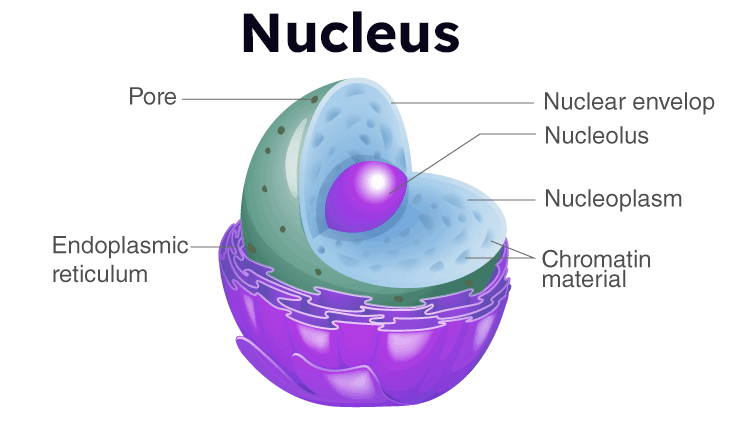
Nucleus - Structure and Functions
Mar 27, 2023, 16:45 IST
The cell is the basic and functional, structural, and biological unit of all known living organisms. The cell is the smallest unit of life. Cells are called the building blocks of life. The study of cells is called cell biology. The human body consists of trillions of cells, all of which have particular functions. Cells are the basic or key structure of all living organisms. The cell provides structure to the body, receives nutrients from food, and performs important functions.
There are two types of cells: prokaryotic (bacteria) and eukaryotic (plant, animal, fungi). Prokaryotes do not have a nucleus - the DNA is in the cytoplasm and can form small circular strands of DNA called plasmids. Similarly, all eukaryotic cells have their DNA enclosed in a nucleus. A nucleus is an organelle that contains the genetic information for that organism. In an animal cell, the nucleus is located in the central location of the cell. Likewise, in a plant cell, the nucleus is located more on the periphery because of the large water-filled vacuole in the center.
| Table of Content |
What is Nucleus?
The important integral component of the cell is the nucleus (plural: nuclei). It is derived from a Latin word “kernel of a nut.”
Nucleus definition-
The nucleus is a spherical organelle that is present in every eukaryotic cell. The nucleus is the control center of eukaryotic cells. It is also responsible for gene coordination and gene expression. The structure of the nucleus includes the nuclear membrane, chromosomes, nucleoplasm, and nucleolus. The nucleus is the most prominent organelle compared to other cell organelles, making up about 10 percent of the cell's volume. In general, a eukaryotic cell has a single nucleus. However, some eukaryotic cells, like red blood cells, are enucleated cells (without a nucleus). Some are multi-core; it consists of two or more nuclei, such as mucus.
A nuclear membrane separates the nucleus from the rest of the cell or cytoplasm. A nucleus was the first organelle to be detected or discovered. Antonie van Leeuwenhoek observes a "lumen" in the nucleus in salmon red blood cells. Unlike mammalian red blood cells, those of other vertebrates still contain nuclei.

Discovery
The nucleus was first observed by Robert Brown (1831). Nucleus plays determinative (in heredity) role in cell and organism, that was experimentally demonstrated by Hammerling (1934) by conducting surgical experiments with green marine unicelled algae Acetabularia.
Occurrence
A true nucleus with definite nuclear membrane and linear chromosome, is present in all the eukaryotes except mature mammalian RBCs, sieve tube cell of phloem, tracheids and vessels of xylem. The prokaryotes have an incipient nucleus, called nucleoid or prokaryon or genophore or false nucleus or bacterial chromosome.
Shape of Nucleus of a cell
It varies widely, generally spherical e.g. cuboidal germ cells, oval e.g. columnar cells of intestine, bean shaped in paramoecium, horse-shoe shaped in vorticella, bilobed, e.g. WBCs (acidophils), 3 lobed e.g. basophil, multilobed e.g. neutrophils, long and beaded form (moniliform) e.g. stentor and branched in silk spinning cells of platy phalyx insect larva.
Size of Nucleus
The size of nucleus is variable i.e. 10-15m. In metabolically active cells size of the nucleus is larger than metabolically inactive cells. The size depends upon metabolic activity of the cells. It is directly proportional to number of chromosomes.
Nucleus Structure
The cell nucleus contains a nuclear membrane called the nuclear envelope, nucleoplasm, nucleolus, and chromosomes. Nucleoplasm, also known as karyoplasm, is the matrix present inside the nucleus. The nuclear membrane separates the components of the nucleus from the cytoplasm. Like the cell membrane, the nuclear envelope contains phospholipids that form a lipid bilayer. The envelope generally helps to maintain the shape of the nucleus and also assists in coordinating the flow of a molecules into and out of the nucleus through the nuclear pores. The nucleus of a cell contains DNA. DNA controls the form, growth, and function of a cell. A nucleus is similar to the brain in coordinating all cellular activities. The most important components of the nuclear structure are mentioned below.
The Parts of the Nucleus are:
- Nuclear membrane or envelope or karyotheca
- Chromatin threads or nuclear reticulum
- Nuclear sap or nucleoplasm or karyolymph
- Nucleolus.
Characteristics of Nucleus
The important features are mentioned below-
- A nucleolus disappears in the late prophase stage.
- One or more nucleoli is present within a nucleus. Four nucleoli are usually found in each nucleus in an onion.
- It is a storehouse of RNA.
- Reappears in the telophase stage
Nucleus Function
- It contains cellular heredity information and controls its growth and reproduction.
- The nucleus was clearly explained as a membrane-bound structure containing the cell's genetic material.
- It is not only a storage space for DNA but is also home to some important cellular processes.
- First of all, it is possible to duplicate one's DNA in the nucleus. This process has been called DNA replication, creating an identical copy of the DNA.
- Creating two identical copies of the body or host is the first step in cell division, where each new cell receives its own set of instructions.
- Second, the nucleus is the site of transcription. Transcription creates different types of RNA from DNA. Transcription would be akin to making copies of the human body's individual pages of instructions that can be moved and read by the rest of the cell.
- A central rule of biology states that DNA is copied into RNA and proteins.
Distribution of Nucleus
Different cell types are categorized based on the presence or absence of a cell. The different types are listed below.
- Uninucleate cell: Also referred to as monokaryotic cells, mostly plant cells that contain a single nucleus.
- Bi-nucleate cell: It is also called a dikaryotic cell. It contains two nuclei at once. Examples are a single paramecium (a mega and a micronucleus), a balantidium, and liver and cartilage cells.
- Multinucleate cells: It is also known as a polynucleated cell that contains more than 2 nuclei at a time—for example, plant latex cells and latex vessels. In animals, striated muscle cells and bone marrow cells.
- Enucleate cells: Cells without a nucleus are called enucleate cells. However, some living cells, such as mature phloem sieve tubes and red blood cells of mature mammals, lack nuclei.
Frequently Asked Question (FAQs)
Q1. Why is the nucleus critical in our life?
Ans. It regulates and controls the cell's activities (e.g., growth and metabolism) and carries the genes and structures that contain the hereditary information. Nucleoli are small bodies often seen within the nucleus.
Q2. What controls entry into the nucleus?
Ans. The nuclear pore is a protein-lined channel in the nuclear envelope that regulates the transportation of molecules between the nucleus and the cytoplasm.
Q3. What controls entry into the nucleus?
Ans. The nuclear pore is a protein-lined channel in the nuclear envelope that regulates the transportation of molecules between the nucleus and the cytoplasm.
Q4. Which type of cell has a nucleus?
Ans. Eukaryotes
Q5. Does nucleus rotate?
Ans. If the distribution of mass or /and charge within the nucleus becomes non-spherical then the nucleus will be able to rotate. The rotation is known as “collective” because many of the nucleons (the protons and neutrons) are involved.









